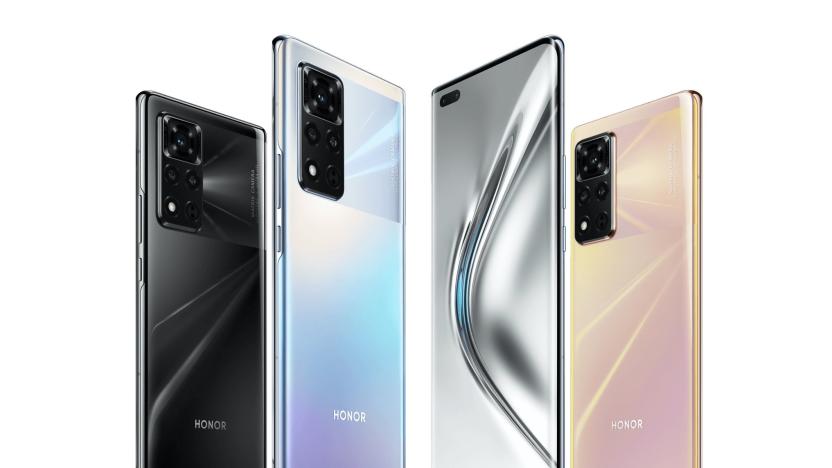120 Hz
Latest

'Genshin Impact' now supports 120 fps on the iPhone 13 Pro and iPad Pro
The popular iOS game Genshin Impact is taking advantage of the iPhone 13 Pro's higher-refresh ProMotion display with a new 120fps mode.

The View40 is Honor's first phone after splitting from Huawei
Honor has unveiled the flagship View40 5G, its first phone since it was sold off by Huawei.

NHK 8K Super Hi-Vision camera captures native 120Hz footage, we go eyes-on at IBC (video)
We've seen plenty of 4K cameras, and we've even heard a whisper or two about 8K, but the quality of a viewing experience isn't tied only to resolution -- frame rate also comes into play, especially with fast-moving subjects. NHK's prototype Super Hi-Vision camera doubles the capture rate from the standard 60Hz to a much speedier 120Hz, yielding sharper motion. While the difference isn't noticeable with static or slow-moving scenes, it certainly comes into play when filming rapid-motion sporting events or panning the camera. The Japan Broadcasting Corporation's latest model was on hand at IBC in Amsterdam, and the advantages of a 120Hz cam were immediately crystal clear. Filming a rotating image that paired ordinary objects and cityscapes with letters and numbers, you could see the difference instantly, with the 120Hz image on the right side yielding far shaper details, while the left side was often a blurry mess. There's no software smoothing on hand here -- because the higher frequency comes directly from the source, it appears perfectly natural, and much more pleasant. We captured a video demonstrating the expo floor rig, but because our camera doesn't sport the same spec, you won't notice a difference in the hands-on clip after the break. You can see the difference in our stills gallery below, however, and you can take us on our word -- the improvement is quite dramatic.%Gallery-164700%

Vizio XVT CinemaWide TV goes on sale, 21:9 movie purists celebrate the end of black bars
It's been a long, long wait for Vizio's ultrawidescreen LCD TV to show its face: the company was promising such sets starting around this time last year that ultimately missed the October and subsequent March targets. Vizio is one to eventually make good on a promise, though, and has just started shipping the first XVT series CinemaWide set. The lone 58-inch model's focus remains on that 2560 x 1080p screen, whose stretchy 21:9 aspect ratio fits what you often see at the movie theater without having to crop or adjust like you would with a typical 16:9 set. Whether or not you have a chronic aversion to black bars, the CinemaWide is still a respectable set in its own right, with edge-based LED backlighting, a 120Hz refresh rate, a Bluetooth remote and the common host of Vizio internet apps. The TV maker must be doing a form of penance for taking its time on the 21:9 display: the $2,800 regular price is a lot lower than the originally quoted $3,500, and you can pick up the CinemaWide TV for $2,500 if you act quickly.

PSA: Real LCD HDTV refresh rates are getting harder to find behind marketing fluff
Electronics makers love a spec they can get behind and make the center point of their marketing efforts -- no matter how useless it is as a comparison. The undisputed be all arms race HDTV metric for the past few years, LCD refresh rates, has recently become even muddier according to HD Guru. Terms like Clear Motion Rate (Samsung) and Scenes Per Second (Vizio) are meant to confuse the customer while resembling the somewhat useful (and, as of late, unmentioned on the box) refresh rate. Our advice? Ignore this spec completely and instead find a TV that can accurately display your favorite content at its native frame rate (24, 30 or 60) -- leave all that soap-opera looking frame interpolation technology to the modern day twelve o'clock flasher.

Sharp LE830 series HDTVs now shipping: edge-lit LED, WiFi, no 3D
Add another to your list of new HDTVs to keep an eye out for, as Sharp has announced its new LE830 series LCDs are shipping this month from its 10th generation plant. This lineup doesn't include any slick 3D features or the size of its 70-inch behemoth from CES, but they are imbued with Quattron quad pixel tech, 120Hz refresh rates, edge LED lighting and built in WiFi. The jury's still out about whether the extra yellow pixel is a positive influence, but included wireless internet access is unfortunately still not a given for all new HDTVs and it will come in handy if you plan to use the included Netflix, Vudu and CinemaNow movie streaming apps. The line ranges in size from 40- to 60-inches, and the MSRPs are between $1,299 and $2,799. Check after the break for the rest of the details and price breakdown, plus a video of their CES presentation.

Poll: Do you turn your HDTV's motion processing on or off?
TruMotion, expletive inducing Auto Motion Plus, MotionFlow, every manufacturer has some slick name for its 120Hz / 240Hz / 480Hz etc. motion processing technology that speeds up the refresh and interpolates frames for an ostensibly smoother video experience, but we know that isn't always the case. It can vary from the implementation to the content viewed, but after the "triple ball effect" and experiencing one too many films that suddenly look like soap operas, finding out how to disable the effect is one of the first things we've learned how to do on many TVs. Of course, everyone has their preference, let us know how you feel and when it's best put to use.%Poll-56018%

ASUS' 23-inch VG236H 3D monitor gets reviewed: pricey, but a real looker
ASUS' VG236H was quietly announced back at CeBIT, but the 23-inch 3D monitor is just now getting around to making itself known to worldwide retailers. On sale now for a penny under $500 (which includes the complete $180 NVIDIA 3D Vision kit), this 1080p display has also managed to hit the test bench over at Hot Hardware. Critics over there found that it was amongst the nicest looking TN (boo) panels out there, and that the third dimension had no issue popping out on command. In fact, they had little to complain about, noting that it "consistently hit the mark in their testing [while producing] a fantastic image, whether it be 2D, 3D, work or play." Granted, it's not like you've too many options when it comes to snagging a 3D LCD, but at least we're hearing this particular one is worth a look (or three).

Viewsonic delivers its own $99 3D glasses
Say hello to the latest competitor in the 3D glasses market as ViewSonic has unwrapped its PGD-150 shutter shades. Don't expect to set these up with those IR-syncing flat panels that are all the rage recently however, these particular glasses are designed for DLP Link compatible 3D projectors... like the ones ViewSonic sells. With a reported 50ft effective range and 70 hour battery in a ruggedized design, we're figuring these are probably more suited to a workplace environment that so many of the projectors we've seen are destined for, but if you want to wear them in your own living room we won't stop you.

Sharp debuts 60-inch 240Hz Aquos LED LCD TV, 68-inch set with a touch of yellow in its RGB
Like the steady hand on your wristwatch, Sharp is arriving at CES with a handful of new television sets... so let's get on with the show! This year, the Aquos LED LCD TV series is touting an impressive 1.6-inch thin frame, Energy Start Version 4 compliancy, and "four primary color technology" -- in a nutshell, it's a "RGB-meet-Y for yellow" world. The LE920 flagship series comes in 52, 60, and 68-inch models with Aquomotion 240 and edge-lit LED; those are due in May with prices listed firmly as TBD. The LE820/810 series hits the slightly tinier, 60, 52, 46, and 40-inch screen size markets and boasts 120Hz frame rate conversion and 4ms response time. They're slightly more within your reach, debuting in March with prices ranging between $1,800 and $4,000. Looking for something even faster? Meet the 60-inch E88UN with a 240Hz refresh rate alongside a X-Gen panel -- mum's the word on pricing, but it'll be the first of these out, in February. Presser after the break.

Samsung rolls out 8 new HDTVs, new 40-inch LED backlit LCD
Samsung's Series 7 / 8 / 9 plasmas and LCDs have broken cover already in Europe or North America, including the slim PAVV Bordeaux 850 (pictured), but Asia gets first crack at the latest iteration of the company's local dimming LED backlighting tech trickling down into the 40-inch LCD size range. Auto Motion Plus 120Hz technology, 1080p, 2,000,000:1 contrast ratios are a must, while also substituting direct YouTube access for the U.S. version's USA Today-powered InfoLink RSS service. No word on the prices the newly expanded Bordeaux line, but we're more interested in how soon the latest in backlighting technology is moving downmarket.Update: Not first, just new, although that shouldn't sate our appetite for a future LN40A950 one bit. [Thanks to all for pointing that out]

LG takes thin to the next level with the 1.7-inch LGX LCD HDTV
LG's 2008 lineup continues with the 42-inch LGX Super Slim 1.7-inch LCD, combining that ultra-thin form factor that's so in vogue with high-tech features like 120Hz, 24p playback capability and ISFccc calibration. LED backlighting and a 15,000:1 contrast ratio bump up the visuals for viewers, while the red-colored back gives your living room wall a show too. The set sports four HDMI 1.3 ports and a USB jack for photos and music, and LG's SimpLink control protocol enables compatible equipment to chain together. Pricing and availability were not announced. %Gallery-12756%

Vizio intros Black Tie LCD lineup with 120Hz, MEMC technology
Trust us, these certainly aren't the only new LCDs that Vizio is doling out today, but you've got to start somewhere, right? The firm's new Black Tie family consists of the 42-inch SV42LF and the 47-inch SV47LF, both of which rock that 1080p goodness, 120Hz processing, 6,500:1 contrast ratio, four HDMI 1.3 inputs, an integrated NTSC / ATSC / Clear-QAM TV tuner, on-board Dolby 3.0 processing, Motion Estimation Motion Compensation (MEMC) and a side access "HD Game Port" with an HDMI input. These units also feature slimmer bezels than those found on Vizio's past sets, and should be available this July for $1,499 and $1,899, respectively.

LG prices wooden-framed 120Hz Xcanvas LCDs
LG has begun shipping those wooden-framed LCDs that were announced back in August, with three models priced at 3.4 million won ($3,621 US) for the 42-inch 42LY4D model, 4.5M won ($4,793) for the 47-inch 47LY4D, and 5.5M won ($5,858) for the 52-inch 52LY4D at Korean retailers. All sets include 178-degree "TruV" viewing angle, a USB port for multimedia content viewing, and the 120Hz 1080p XD engine. No word on whether you can get it in a black cherry finish to match your bedroom armoire.





